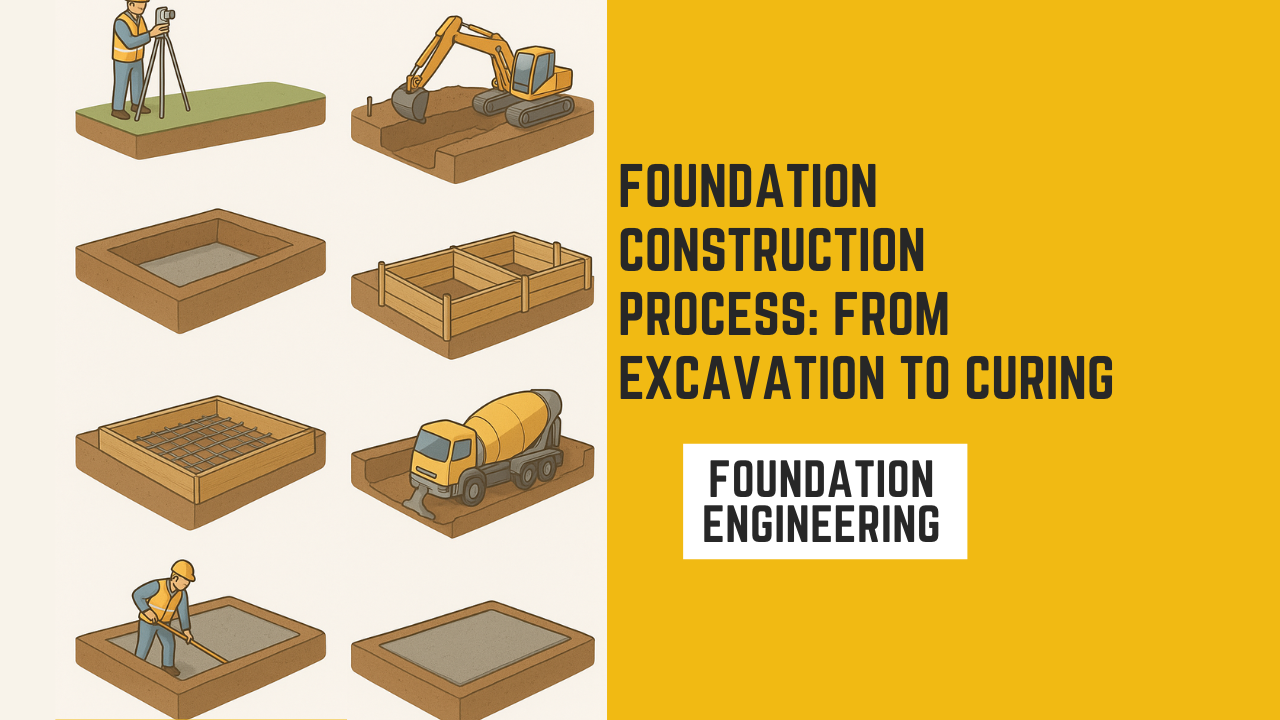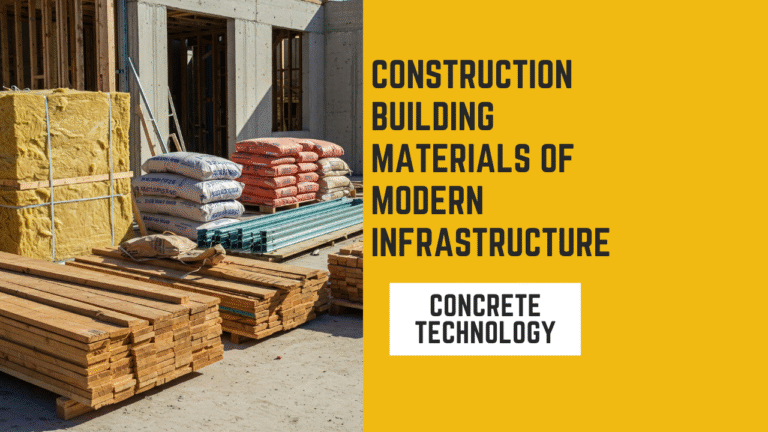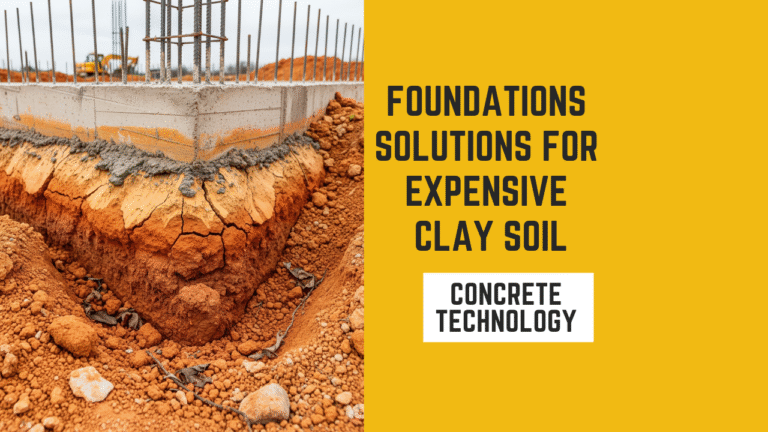Foundation Construction Process: From Excavation to Curing

Introduction
In civil engineering and building construction, the foundations is the most critical component of any structure. A well-designed and properly constructed foundation ensures that loads are transferred safely to the ground, providing strength, stability, and long-term durability. From excavation to curing. Every stage in foundation construction plays a vital role in the overall performance of a building
This article explains the step-by-step foundation construction process, covering excavation, formwork, reinforcement, concrete pouring, and curing. Whether you are a civil engineering student, a professional contractor, or a owner, understanding these stages will give you valuable insights into one of the most essential aspects of construction
Types of foundations in construction
Before diving into the process. It’s important to understand the two main types of foundations:
1. Shallow Foundations
- Used for smaller buildings and lighter loads.
- Examples: spread footing, mat (raft) foundation and strip footing
2. Deep Foundations
- Used when soil bearing capacity near the surface is weak
- Examples: pile foundations, drilled shafts and caissons
For most residential and commercial projects, shallow foundations are common, so the process described below mainly applies to them
Step-by-step foundation construction process
1. Site survey and soil testing
The first step in foundation construction is site investigation. Engineers conduct soil tests to determine
- Soil bearing capacity (SBC)
- water table level
- Soil type and compaction properties
These parameters influence the type and depth of the foundation. For instance clayey soils may require deeper foundations, while sandy soils may need wider footing
Soil testing ensures that the foundation design matches ground conditions, preventing settlement and cracks in the future.
2. Excavation
Once the design is finalized, excavation begins.
- Marking the Layout: Using lime powder, pegs, or chalk, the foundation lines are marked on the ground
- Excavation work: Excavators, backhoes, or manual labor remove soil to the required depth and width
- Shoring and Dewatering: If the soil is loose or water is present, temporary supports (shoring) and pumps are used to keep the excavation safe and dry
Proper excavation is crucial because uneven or over-excavated areas can cause instability in the foundation
3. Laying the PCC (Plain Cement Concrete) Bed
Before reinforcement and footing are placed, a thin layer of PCC (1:4:8 or 1:5:10 mix ratio) is laid at the bottom of the excavation.
Purpose Of PCC
- Provides a clean and level surface.
- Prevents direct contact of reinforcement with soil (avoiding corrosion).
- Distributes load uniformly
4. Foundation Formwork
Formwork refers to temporary molds used to hold concrete until it sets. In foundation construction
- Wooden or steel shuttering is installed around the excavation.
- Formwork ensures the footing or slab has the correct shape, and alignment
- Proper formwork prevents leakage of cement slurry during concrete pouring.
5. Reinforcement Placement
Reinforcement bars (rebars) are placed inside the formwork according to structural drawings.
- Steel Cutting and Bending: Bars are cut and bent as per the bar before bending (BBS).
- Typing reinforcement: Rebars are tied together with binding wire to form a cage
- Cover Blocks: Small concrete blocks are used to maintain the required cover (distance between reinforcement and formwork).
Reinforcement provides tensile strength, preventing cracks and failure under load.
6. Pouring Concrete
This is the most critical step in foundation construction.
- Concrete mix designs: Generally, M20 or M25 grade concrete is used in foundations.
- Mixing: Concrete may be mixed manually for small projects or by batching plants for large projects.
- Pouring: Concrete is poured into the formwork in layers.
- Compaction: Vibrators are used to remove air bubbles and ensure proper compaction.
Well-compacted concrete ensures strength and prevents honeycombing (voids).
7. Finishing and Levelling
After pouring and compacting, the top surface of the foundation is finished
- A screed or trowel is used to quantify the surface
- A surface finishing ensures a smooth base for further construction
8. Curing the Foundation
Curing is one of the most overlooked yet most important steps in foundation construction.
- Purpose of Curing: Maintains moisture in concrete, ensuring hydration and strength development
- Methods
- Ponding (Storing water on surface) Sprinkling water at intervals
- Covering with wet burlap or hessian cloth
- Duration: At least 7 days for ordinary Portland cement (OPC) and 10–14 days for blended cements.
Without proper curing, concrete may develop cracks and lose strength.
Additional Considerations in Foundation Construction
1. Waterproofing
- Damp proofing (DPC) or waterproof membranes are applied to prevent moisture penetration.
2. Backfilling
- After curing, excavated soil is refilled around the foundation in layers, compacted properly to avoid settlement
3. Quality Control
- Concrete cubes are tested for compressive strength
- Reinforcement placement is checked against drawings
- Formwork alignment is inspected before pouring.
Common mistakes in foundation construction
Even small errors can lead to major structural failures. Some common mistakes include:
- Inadequate soil testing before construction.
- Poor compaction of soil below the footing
- Incorrect reinforcement placement
- Insufficient curing time
- Using low-quality materials
Avoiding these mistakes ensures durability and safety.
Importance of Proper Foundation Construction
- A properly built foundation ensures:
- Load transfer efficiency—distributing structural loads safely to soil.
- Durability—preventing cracks and water seepage.
- Structural stability—resisting earthquakes, floods, and settlement.
- Cost efficiency—avoiding expensive repairs in the future.
Modern technologies in foundation construction
The construction industry is rapidly adopting modern technologies to improve foundation quality and efficiency. The use of ready-mix concrete (RMC) ensures consistent quality compared to on-site mixing, reducing the risk of errors. Self-compacting concrete (SCC), another innovation, flows easily into reinforcement cages without vibration, ensuring dense and durable foundations. Additionally, digital monitoring tools such as sensors embedded in concrete can track temperature, moisture, and curing conditions, allowing engineers to verify strength development in real time. These technologies not only improve accuracy but also save time and reduce labor costs.
Conclusion
The foundation construction process—from excavation to curing—is a systematic procedure that requires careful planning, skilled execution, and strict quality control. A strong foundation is the backbone of any structure, ensuring safety, durability, and long-term stability
A well-designed and properly constructed foundation ensures that loads are transferred safely to the ground, providing strength, stability, and long-term durability.
By following proper procedures at every stage—soil testing, excavation, PCC laying, reinforcement, concrete pouring and curing —engineers and contractors build reliable foundations that stand the test of time






